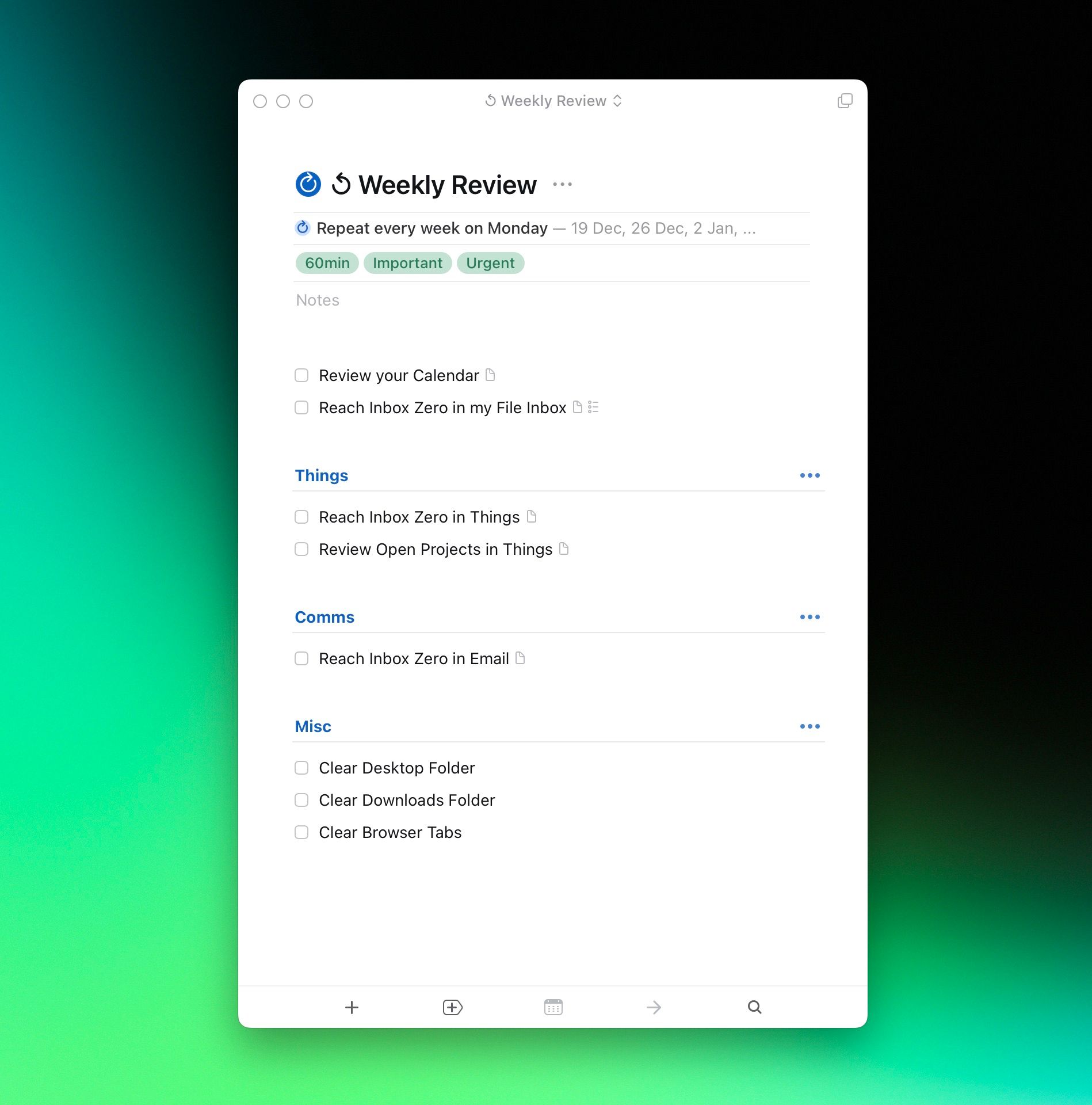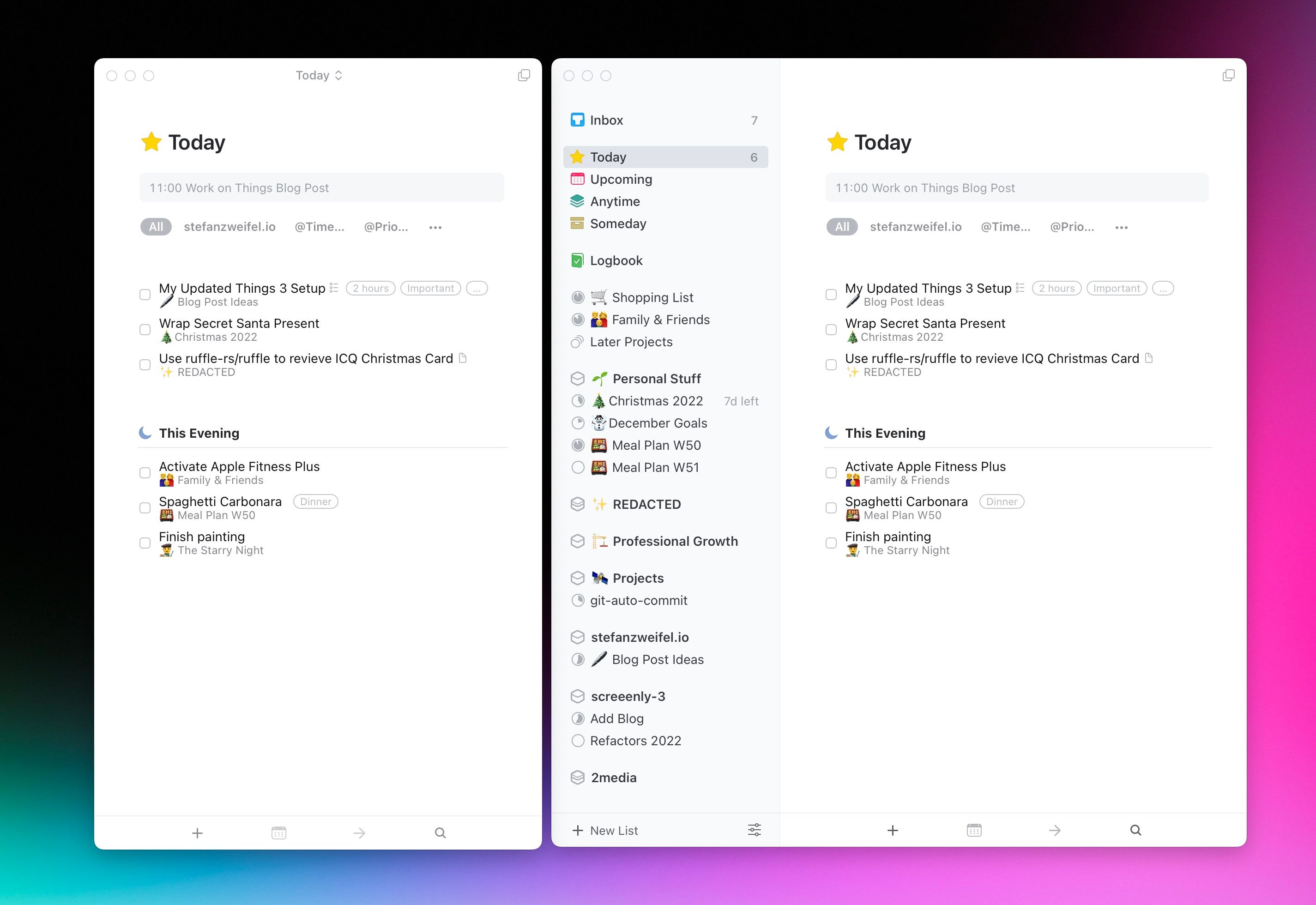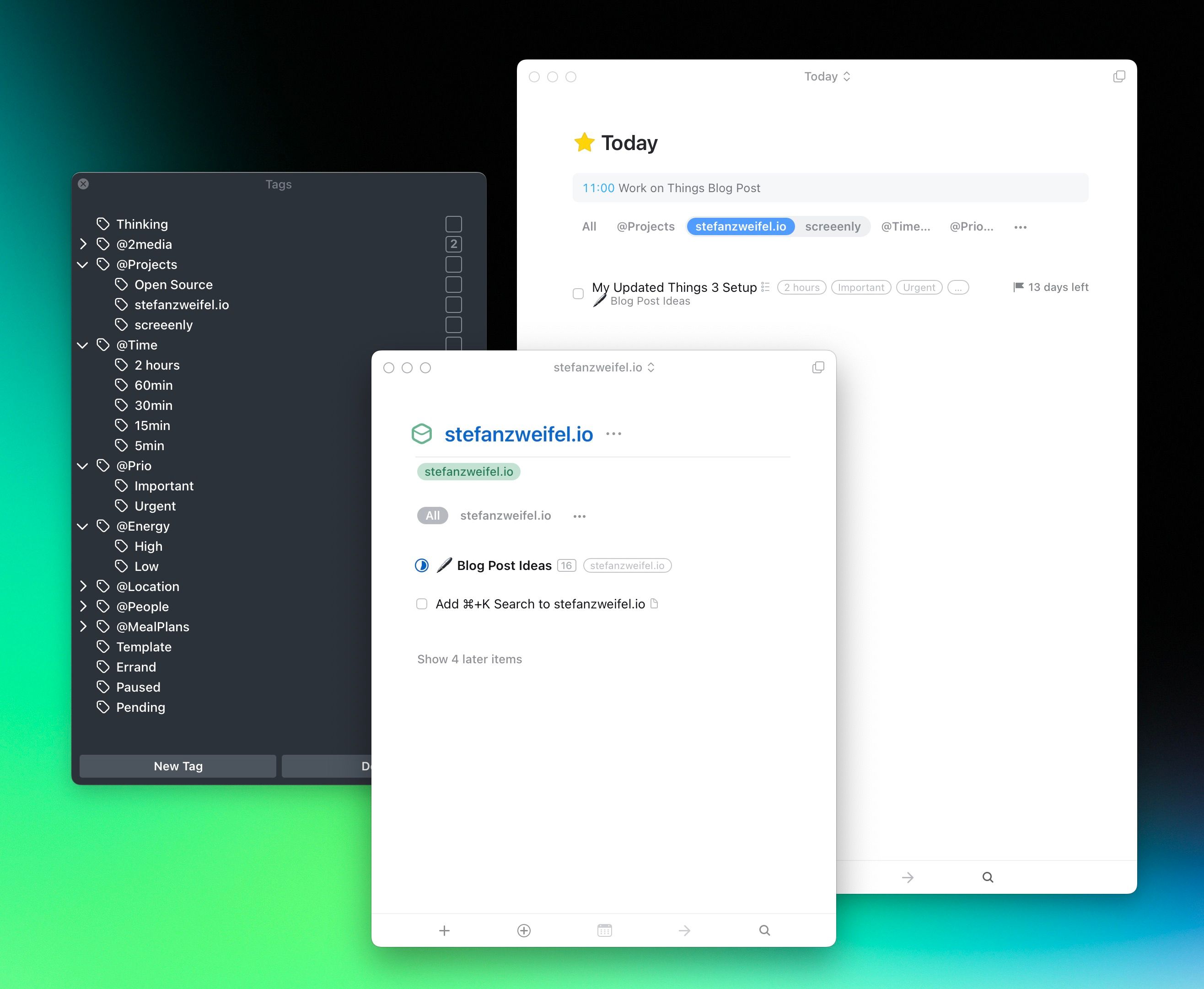My updated Things 3 Setup
Things 3 is still my favourite todo list app. To this exact day, I've been using it for 5 years and 1 month.
I wrote about how I use Things 3 years ago.
Since then, my approach of using the app hasn't changed fundamentely. But after (finally!) reading Getting Things Done earlier this year, I've tweaked my setup quite a bit: Old systems got torn out. New habits formed. Tags have been shifted.
Today I would like to give you an update on how I use Things and how it helps me stay on top of my daily tasks.
Getting a hold of the Inbox #
Before reading Getting Things Done my Inbox regularly contained more than 30 or 50 tasks. It got overwhelming.
I dreaded adding new tasks to the Inbox. Instead, I let other systems act as todo lists: My email inbox, my GitHub notifications, my browser tabs. You probably know what I'm talking about.
The issue was, that I didn't regularly review my Inbox. There was no ritual where I would take a look at the Inbox and decide, which task to keep and which to throw away. I just let it pile up.
Once in a blue moon, I would start chipping away at this big list of tasks and started working on them immediately. This felt wrong. Getting Things Done confirmed my believe:
Emptying the contents [of the Inbox] does not mean that you have to finish what’s there; it just means that you have to decide more specifically what it is and what should be done with it, and if it’s still unfinished, organize it into your system.
The book also brought the solution: the Weekly Review.
Every Monday evening I sit down for up to an hour and do my Weekly Review. I go through my Inbox, look at each task and decide if it's still relevant or if it can be archived. If it's still relevant, I sort the task into one of my areas or projects.
During the Weekly Review I also do some other tasks. See the screenshot of my recurring project below.

This new ritual has done wonders for me. I'm no longer anxious about my todo list inbox.
Instead of not adding tasks to the inbox anymore, I now add ideas, tasks and notes throughout the week to Things again.
Another benefit of the weekly review: The size of my Inbox has become significantly smaller. As I do this every Monday, there are usually not more than 5 to 10 tasks in the Inbox.
And the habit of "immediately start working on tasks" whenever I look at the Inbox is also gone. Weekly Review is just here to sort the tasks into areas and projects.
(I make an exception if the task is simply to download and file a PDF or something that only takes a minute or two.)
Simplified Areas #
In my previous post I shared screenshots of the areas in my Things app.
Back then I thought many areas are a good thing. I changed my mind and cut down the number of areas.

As you can see in the screenshot, there are now only 7 areas left; from previously 13 areas.
Personal Stuff #
As the name suggests, this area contains projects related to my personal life.
It's the place for my weekly meal plans, my monthly goal projects, trips I plan to take or any other tasks that is vagely related to me.
It's also the place for all the chore-tasks and repeating-projects like "cleaning the apartment windows" or "doing my taxes".
Professional Growth #
The "Professional Growth" area contains projects and tasks related to learning. If I see a new package, programming language or tech related book, the task is put into this area. For example:
- "Read RFC 9116"
- "Learn more about Tauri and create a simple project with it"
- "Update keybinding in tmux configuration"
I also have a couple of repeating tasks in this area. For example:
- "Write down work achievements for the previous month": At the beginning of each month I take a look at the pull requests merged in the previous month. For significant or important pull requests I make a note in an ongoing "Work Achievements" note. Having such a list is helfpul when preparing for my performance review or just as a reminder of the work I've done in the past few months.
- "Watch at least 1 Laracasts video": A regular task reminding me to watch at least 1 – ususally more – Laracasts videos. I've learned a lot through Laracasts over the years and has been a vital resource to learn new tools or refresh the basics. (Currently enjoying the Neovim Series by Jess Archer)
Projects #
Haven't improved on the name, but "Projects" is the place for tasks related to my open source projects.
As I've disabled email notifications in GitHub and work with the notifications panel, I started creating tasks in Things for issues or pull request that need my input.
I ususally do this by using the Quick Entry feature by pressing ⌃⌥Space.
Bigger projects – like git-auto-commit – get their own Things project to keep the tasks a bit more organised.
Obviously I just don't store links to issues and pull requests here. For example, new OSS projects or tasks related to new features get their own projects too.
stefanzweifel.dev #
This blog has it's own area. It's where I keep all my ideas for blog posts I want to write or a list of stuff I would like to improve or change on the website. (I've moved domains in January 2023. That's why the domain in the screenshot doesn't match.)
screeenly-v3 #
The only revenue-generating side project also gets its own area.
Here I collect tasks for reported bugs, new features, refactors, or general ideas for the project. The area also contains repeating tasks and projects related to accounting.
2media #
The last area is related to my day job at 2media.
Before 2022, I had no work related task in Things. I wanted to keep my personal and "work" tasks separated. I can't remember why.
For a long time I wrote down my tasks in a physical and later in a digital Bullet Journal.
Earlier this year I saw that Dries Vints kept all his personal and work related task in the same app and I questioned my self, why I don't do the same. Why would I use a separate physical or digital tool for my work tasks?
The next day I transfered all my open work related task to Things and never looked back.
At 2media, we currently use Asana to manage our projects, but it's not the right tool for me to store granular tasks I might want to keep track of.
For example a recent project of mine was replacing CSS Modules with Tailwind CSS in a Vue.js project.
As only I was working on the project, I didn't add a task like "Fix spacing issue in RadioList-component" in Asana, but rather in Things.
I want to keep track of such tasks somewhere and Things is the best place for me. The app is ususally open on my second monitor and tasks are filtered to only show tasks labeled with @2media (more on that later).
I also do a separate Weekly Review each Friday, where I go through all task in this area and our projects in Asana. Taking that 30 minutes each Friday helps me to keep a clear head and to stay on top of all the projects that are currently active at work.
Minimal Today List #
My most used list in Things is the Today list.
With so many project and areas, the Today list quickly becomes cluttered if there are many tasks scheduled for today and if only a single task is scheduled per project.
While watching one of Craig Mod's livestreams, I saw that his Things was quite calm. Even though he had many projects, they didn't show up as headings.
After checking the settings, I noticed the "Group to-dos in the Today list by project or area" configuration. Once disabled I had the same layout as Craig and a much more minimal list.[1]
Split between day and evening #
I'm also a heavy user of the "This Evening" time setting. Each morning, while walking to the gym, I split the tasks scheduled for today into day and evening tasks.
In practical terms, this ususally means all day-work related tasks remain in the "day" list, the rest moves to "This Evening".
Tags #
I'm in my fifth year of using Things and I'm still not sure if I use tags in the most optimal way.
In my original post, I had tags for:
- time ("@Time")
- priority ("@Prio")
- energy ("@Energy")
- location ("@Location")
- people ("@People")
All these tags still exist and some tasks are labeled with them, but I rarely filter my lists by them.
The sole change I made in the past few years, is creating tags and tag groups related to my day work ("@2media") and for my bigger projects ("@Projects/screeenly", "@Projects/stefanzweifel.dev").

These tags have been applied to the corresponding areas, so that all tasks in the area and projects can be filtered by the tag.
This comes in handy, when I want to filter my Today list to only show tasks related to my day work at 2media, or when I work on screeenly or my blog.
So far, the setup worked okay for me. But as mentioned, I'm not sure if this is "the right way™".[2]
I will probably remove the "@Energy"-labels soon, as I rarely add them to tasks and even rarer filter by them.
Other Stuff #
I disabled the red notification badges for most apps on iOS and macOS for a while now. Recently I also disabled them for Things.
I don't want to constantly see that I have 12 tasks open, or that there are 3 tasks with deadlines waiting to be completed. When I open the Things app I already see that in the sidebar.
Disabling badges gave me a bit of peace of mind back. You should give it a try (not just for Things, but for all apps).
Another recent change is that I enabled the Reminders.app integration in Things' settings.
The idea behind this is that I could dictate new tasks to Siri ("Remind me too ___") and see them pop up during my Weekly Review in the Inbox. So far I've used this only once or twice.
I've also removed all repeated tasks from Things that could be described as "habit forming" tasks. For a long time I had tasks like "Floss teeth", "Write 280 Characters Today" or "Meditate for 10 minutes". I've migrated such tasks to the Streaks app.
Conclusion #
Things 3 is a central piece of software I use in my daily life. I don't know how I would function without it.
It took a while to create a system that works for me. I'm sure I will make small corrections in the future, to align it with my duties at my day-job or with my personal goals.
There are also still some bad habits, like scheduling too many task in advance with the indention, to work and complete them on that day. That ususally just leads to unnecessary stress and is a thing I want to change. The goal is to have an empty Today list and then look at the Anytime list and pick tasks that I should work on.
One thing that will bind me to Things for – hopefully – many years to come, is the absence of change. So many apps and services overhaul their UI or design every couple of years; for the worse in most cases.
Things 3 has looked and felt the same for 5 years. It feels snappy and there isn't much I would like to see changed.[3] I hope it will keep that way and CultureCode doesn't start adding vanity features demanded by a small minority that aren't well thought out.
If you have any questions about my setup, feel free to reach out to me through email, Mastodon or Twitter.[4]
It took me some time to get used to the setting, but I can't go back know. For me, the default setting wastes too much space and doesn't bring any real benefit to me. I don't need to see the percentage-pie next to the project name all the time. ↩︎
There probably isn't a "right way" to use tags in any software. I never came accross another persons setup – Things or otherwise – where I thought: "Wow! That's a great use of tags". I think it's one of the paradigms of software we still haven't truly figured out. ↩︎
The only pet peeve I any many others seem to have, is that filtering a list by tags on iOS/iPadOS is too cumbersome. ↩︎
Over the last few years a couple of readers asked questions or gave feedback. Some of the feedback was applied to my setup and it made it better (thanks dear reader). ↩︎